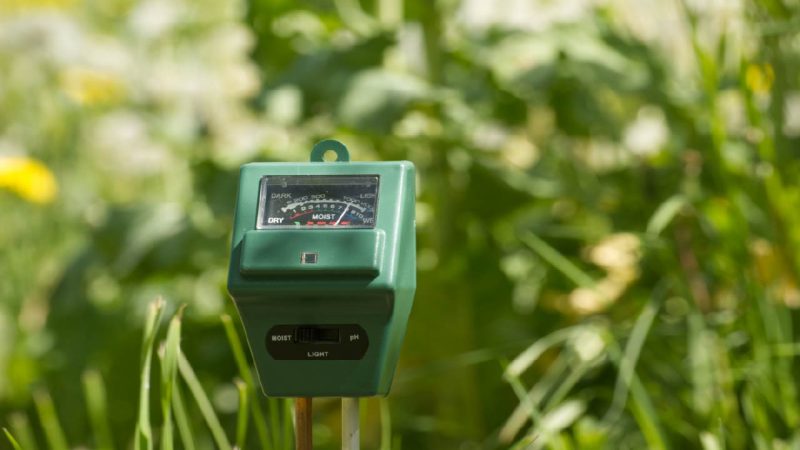Watering plants seems simple, but achieving the perfect balance is often challenging. Overwatering can lead to root rot and fungal diseases, while underwatering stresses plants and stunts growth. A soil moisture meter is a valuable gardening tool that takes the guesswork out of watering. By understanding how to use it properly, you can ensure your plants get exactly the amount of moisture they need.
In this guide, you will learn how soil moisture meters work, the right way to interpret their readings, and expert tips for achieving ideal watering practices for both indoor and outdoor plants.
Table of Contents
Understanding Soil Moisture Meters and Their Importance

Soil moisture meters are simple yet highly effective tools designed to measure the amount of water present in the soil. They typically use a metal probe to detect soil conductivity, which changes depending on the soil’s water content. Some advanced models also include digital displays, pH testing functions, and light intensity readings. Regardless of the type, their main goal remains the same: to help you determine when and how much to water.
The importance of using a soil moisture meter cannot be overstated, especially for gardeners dealing with a variety of plants with different watering needs. Houseplants, for example, require more controlled moisture levels than outdoor shrubs or garden vegetables. By checking soil moisture regularly, you can avoid common watering mistakes that harm plant roots. Healthy root systems directly contribute to strong plant growth, abundant blooms, and increased crop yields.
For those who struggle with keeping plants alive, this tool is a game changer. Instead of guessing whether the soil feels dry or moist by touch, you get a clear, measurable reading. This precise approach is especially useful for beginners who are still learning about plant care and experienced gardeners who want to optimize their watering schedule for maximum plant health.
How to Use a Soil Moisture Meter Correctly
Using a soil moisture meter correctly ensures accurate readings and helps you develop the best watering habits. The process is straightforward, but attention to detail is crucial for reliable results.
Before inserting the probe, ensure the soil is free of stones or hard clumps that might obstruct it. Push the probe gently into the soil, ideally halfway down the root zone of the plant. This is the most critical area where roots absorb water, and readings from this level reflect the actual moisture available to the plant. For potted plants, insert the probe toward the center of the pot rather than just at the edges, as water distribution may differ between the two areas.
Once the probe is in place, wait a few seconds for the meter to stabilize. Analog meters usually have a dial with numbers ranging from dry to wet, while digital ones display percentages. Interpret the reading based on the plant’s watering requirements. For instance, succulents and cacti thrive in dry to moderately moist soil, while tropical plants often prefer consistently moist conditions.
After taking the reading, clean the probe with a dry cloth to remove any soil residue. This step not only extends the life of the device but also ensures consistent accuracy for future readings. Over time, using a soil moisture meter will help you recognize patterns in soil drying rates, allowing you to anticipate watering needs more effectively.
Interpreting Soil Moisture Readings for Different Plants
The key to using a soil moisture meter effectively is knowing how to interpret its readings according to each plant’s unique needs. Not all plants thrive in the same level of soil moisture, so understanding these differences is crucial.
For drought-tolerant plants like succulents, cacti, and some Mediterranean herbs, the soil should dry out almost completely before the next watering. A low reading on the meter, often in the “dry” range, signals the perfect time to water. Overwatering these plants can lead to mushy roots and quick decay.
Tropical and foliage houseplants, such as ferns, calatheas, and philodendrons, prefer a more evenly moist environment. These plants often require watering when the meter shows a reading in the lower to middle “moist” zone. Allowing the soil to dry too much stresses the leaves and may cause them to curl or turn brown at the edges.
For flowering annuals and vegetable gardens, maintaining consistent soil moisture is essential for proper flowering and fruit development. The soil should ideally stay in the middle range of moisture, neither too wet nor too dry. Frequent monitoring with a soil moisture meter ensures these plants receive a steady supply of water, preventing blossom drop and poor yield.
Choosing the Right Soil Moisture Meter for Your Garden
Selecting the appropriate soil moisture meter is another step toward achieving perfect watering practices. There are two main types: analog and digital. Both have unique benefits depending on your gardening style and needs.
Analog meters are simple, affordable, and do not require batteries. They are ideal for casual gardeners who want quick readings without complicated settings. Most analog meters feature a needle that moves across a dry-to-wet scale, making them easy to read.
Digital soil moisture meters, on the other hand, provide more precise readings and sometimes include additional features such as temperature and pH measurements. These are perfect for gardeners who grow sensitive plants or maintain large gardens where accuracy is essential. Digital models often display readings in percentages, which can help you fine-tune your watering schedule with greater precision.
Regardless of the type you choose, look for meters with long, sturdy probes if you are working with deeper garden beds or large potted plants. Ensure the device is made from durable materials to withstand frequent use and various soil types.
Common Watering Mistakes and How a Soil Moisture Meter Helps
One of the most frequent mistakes gardeners make is watering on a fixed schedule rather than responding to the actual needs of the plant. This habit often leads to overwatering or underwatering, both of which damage root systems. A soil moisture meter eliminates the guesswork, allowing you to water only when necessary.
Another common issue is relying solely on surface soil dryness as a watering indicator. While the top layer may appear dry, deeper soil near the roots can still hold plenty of moisture. A soil moisture meter gives you insight into the root zone, preventing unnecessary watering that might suffocate roots.
Some gardeners also struggle with inconsistent watering, especially when caring for plants with varying needs in the same garden. With regular use of a moisture meter, you can create customized watering routines tailored to each plant type, promoting healthier growth and reducing the risk of disease caused by excess moisture.
Improving Plant Health with Consistent Monitoring
Regularly checking soil moisture levels with a meter can significantly improve overall plant health. Consistency in watering supports stable root development, which directly impacts how well a plant absorbs nutrients from the soil. Healthy roots lead to stronger stems, more vibrant leaves, and more abundant flowers or fruits.
By keeping a record of your moisture readings, you can track how quickly different soils dry out. Sandy soils, for instance, lose water faster than clay soils, and potted plants dry more quickly than garden beds. Over time, this knowledge allows you to adjust your watering habits proactively rather than reactively.
Moreover, consistent monitoring helps detect potential issues early. If your soil consistently reads “wet” despite reduced watering, it could indicate poor drainage or compacted soil that needs aeration. Early intervention prevents long-term damage and keeps your plants thriving.
Best Practices for Perfect Watering with a Soil Moisture Meter
Perfect watering goes beyond simply reacting to meter readings; it involves developing good watering habits that complement the tool’s guidance. Always water thoroughly when the soil meter indicates dryness, ensuring moisture reaches the root zone rather than just the surface. Deep watering encourages roots to grow deeper, making plants more resilient to drought conditions.
Adjust your watering schedule according to seasonal changes. Plants generally require more frequent watering during hot, dry weather and less during cooler months. Use your soil moisture meter more often in transitional seasons to keep up with these shifts.
Finally, remember that soil type, pot size, and plant species all influence moisture retention. Combine meter readings with your knowledge of these factors for the best results. Over time, your experience, paired with accurate moisture readings, will help you master the art of perfect watering.
FAQs about Soil Moisture Meters
How does a soil moisture meter work?
A soil moisture meter works by measuring the electrical conductivity in the soil, which changes depending on its water content. Wet soil conducts electricity better than dry soil, allowing the meter to give an accurate reading of how much moisture is available to plant roots.
How often should I check soil moisture with a meter?
You should check soil moisture every few days, especially during hot or dry weather when soil tends to dry out quickly. For indoor plants, monitoring once or twice a week is usually enough, but sensitive plants may require more frequent checks to maintain consistent moisture levels.
Can a soil moisture meter be used for all types of plants?
Yes, soil moisture meters can be used for almost all types of plants, including houseplants, garden vegetables, flowering plants, and shrubs. However, it is essential to interpret the readings according to each plant’s specific watering needs, as not all plants thrive in the same level of soil moisture.
Do soil moisture meters work in all soil types?
Soil moisture meters generally work well in most soil types, including sandy, loamy, and clay soils. However, readings may vary slightly in heavy clay soils or very rocky soil, so it is important to insert the probe carefully and take multiple readings if necessary.
Are digital or analog soil moisture meters better?
Both types are effective, but digital meters provide more precise readings and often include extra features like temperature and pH measurements. Analog meters are simpler, budget-friendly, and ideal for casual gardeners who want quick and easy readings without additional settings.
Conclusion
A soil moisture meter is an indispensable tool for any gardener aiming to achieve perfect watering. By understanding how to use it properly, interpreting readings according to plant needs, and adjusting watering practices accordingly, you can ensure healthier roots, stronger growth, and more vibrant plants.
Whether you are caring for delicate indoor houseplants or managing a thriving vegetable garden, this simple device takes the guesswork out of watering. With consistent monitoring and proper technique, you will soon notice significant improvements in your plant’s health and overall garden success.






